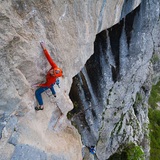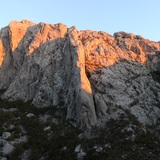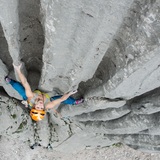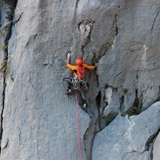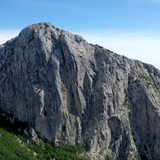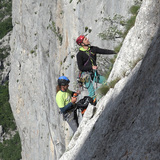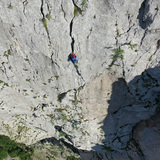This is the biggest and the most grandiose rock face not only in Paklenica but in the entire geographical area. Almost any route on this wall is a special experience no matter what type of climbing we are talking about.
What is El Capitan for international world of climbing that is Anića kuk for Croatia.
The wall of Anića kuk can be divided into three main sections: steep north face (characterized by narrow cracks and chimneys), northwest face that is at the same time the highest rock face, and shorter, not so steep west face. In order to help you with your orientation northwest face is divided into three sections: Klin, Trapez and Stup.
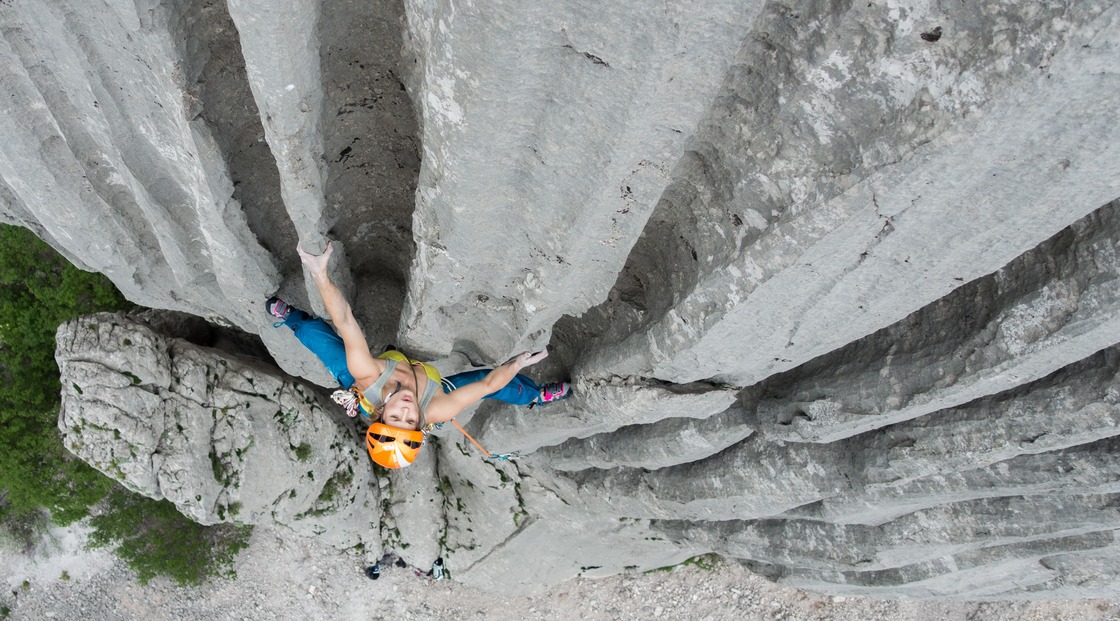
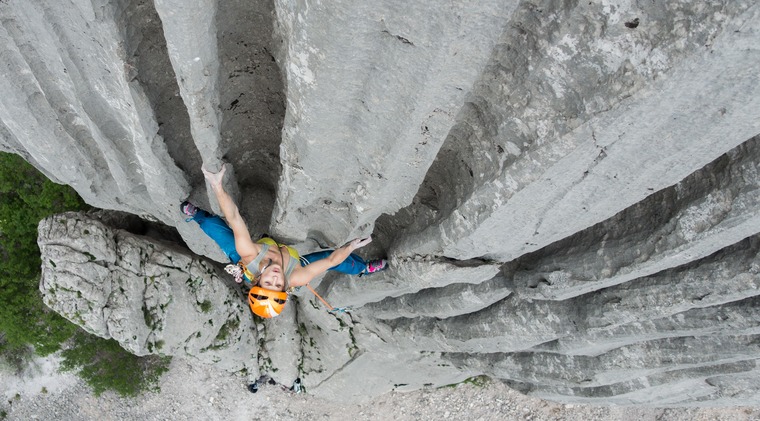

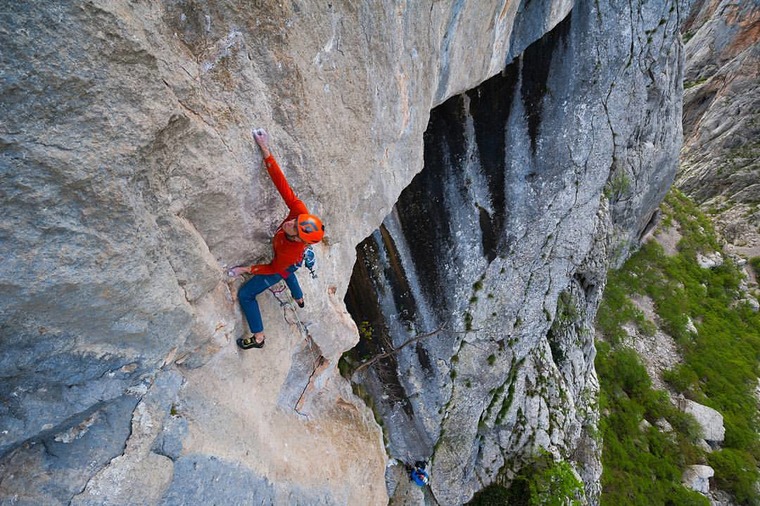
Late 1930s are the period when climbers first came to Paklenica. Dragutin Brahm died in an attempt to climb the Anića kuk face for the first time. The route that he attempted to climb, was eventually climbed in 1940 by S. Brezovački and M. Dragman and they dedicated it to him by naming it Brahmov smjer. During the period that followed, few new routes that are nowadays considered to be classical routes in Paklenica, were opened mainly by Croatian climbers. Those routes are Mosoraški (1957 – B. Kambić, B. Kulić), Velebitaški (1961 – D. Ribarović, N. Jakić, M. Mlinac), Klin (1966 – M. Pleško, S. Gilić, N. Jakić) or Funkcija (1969 – N. Čulić, I. Kaliterna).
During those years climbers from Slovenia started visiting Paklenica, and they soon took the initiative when it comes to first ascents. Especially active were climbers from Ljubljana that climbed routes such as Vražji, Diagonalka or Forma viva.
Following routes remained the last considerable contribution of Croatian climbers for quite some time: Jenjavi (1971) and eight-days climb of Brid klina (1973 – B. Aleraj, M. Čepelak). 1970s represent a new era in climbing here. In 1976 F. Knez first visited Paklenica. He completely changed the concept of climbing and discarded the word impossible. Many of his routes in Paklenica, and there are about forty of them are still considered the most difficult ones. His style has remained modern. Quick ascents with very little gear. It is important to take into consideration his grading method that was usually a whole grade lower than the UIAA grading scale.
I. Tomazin was the one that brought the spirit of free climbing in Paklenica. He made the free ascent on Brid za mali Čekić in 1978 (nowadays its grade would be 6c+). It was the firsf route with grade higher than level 6 on the UIAA grading scale. With his parther M. Ivnik he repeated free the Velebitaški route and climbed two new, beautiful and hard routes: Albatros and EI Condor pasa. Early 1980s were the period when difficulty levels of climbed routes suddenly got higher, those routes were better equipped, and many routes were climbed in other rock faces of Paklenica. In that period quick repeated climbs of particular routes also became very popular, as well as climbing a greater number of routes in one day. In that period there were some clashes betweeh so-called traditionalists and climbers that opted for modern trends in climbing. Nevertheless free ascents took root and aid routes climbing also became popular.
The year 1982 was the turning point. That year F. Knez and I. Tomazin repeated free the Klin route, but they got around the most difficult spot. A year late L. Painkiher and I. Škamperle corrected this flaw by repeating the famous travers (6c+). Other known routes were freed in this period. Funkcija (1983 – I. Tomazin), Šubara and Jenjavi (1984 – T. Slabe), EI Condor pasa (1984 – S. Rehberger). Several new bolted routes across slabs were also opened: Domžalski, Švicarski, Utopija 85, Ona voli rock...
One of the most active climbers of this period was S. Rehberger that freed routes Rio (7a+) and Cvrčev Stup (6c+) in 1986. In the same year together with T. Slabe he solved what was considered to be the biggest challenge to free climbing in Paklenica, and that is the famous Brid Klina (7c). In the mid 80s famous aid routes were climbed: Spomin (S. Karo, J. Jeglič, F. Knez), Rumeni strah (S. Karo, P. Kozjek) and Tango vertical (S. Karo, S. Škarja).
In 1990, Paklenica was visited by brothers Remy, Swiss climbers that climbed two beautiful routes: Rajna and Welcome. Both these routes were climbed in modern style: free, while security bolts were put up in lead. It was during this period that the most difficult aid route were climbed: Jogananda (1989 – M. Praprotnik, M. Ravhekar) that is graded A4.
Due to war circumstances there is a period when all climbing activities came to a standstill. Not before the end of 1995 was the Park reopened for visitors and climbers as well.
The new era was marked by the new route Waterworld that was climbed by Austrians I. Schalk and G. Grabner. Also the action for reequipping the routes in Klanci and Anića kuk was also launched by Austrian climbers.
In the latest period among the most active climbers are Croatian climbers B. Čujić and I. Matković, that take credit for a whole range of new routes, for example Zlatne godine (7c) or Vila Velebita (7b+) in Anića kuk. Ranking as the most difficult routes are also those ones equipped and climbed by Italians A. Michelini and his wife L. Ortolani. Those routes are: Alan fjord (7c), Bubamara (7c/c+), Mjesečina (7c/c+)… Italians P. Pezzolato and his female companion S. Gojak can be considered the real “asset” of Paklenica. They take credit for a whole range of beautitul, well-equipped routes in almost all rock faces of Paklenica.
Recently there is less and less opportunity for the logical new routes. The route Spider should be mentioned as one of the most difficult routes in this part of Europe. It was a project of Marko Lukič and it took him a few years to equipe and climb this route. The route Zenit is considered as some kind of crown of Anića kuk. It is located in the part of sector Klin and it was equipped in the late 2004. by B. Čujić and I. Matković. And it is one of the longest and the most beautiful routes in the Anića kuk. As an interesting thing we can add the fact that in the begining of 2004. the first B.A.S.E. jump has been made from the Anića kuk rock (R. Pečnik, S. Kranjc).
Finally we must point out the local climber Igor Čorko. He equipped and climbed in Anića kuk (with M. Marasovići) route Himalaja sport (7c +). In addition, Igor is free climbed almost all modern routes in the Anića kuk and Debeli kuk. In 2020 Boris Čujić and Ivica Matković returned again to the Anića kuk with new creation Besmrtnici ( Immortals) which can be a modern classic due moderate difficulties.
The area is access sensitive!
🚗
If you want to get to Paklenica you can do it either from the coastal or the continental side:
The coastal option leads from Rijeka by Adriatic Highway, passes Senj, Karlobag all the way to Starigrad- Paklenica (180 km from Rijeka). Zadar is 46 km to the south of Starigrad.
The continental option is very easy. It leads from Zagreb by highway to Maslenica (junction of the Adriatic road) and further on to Starigrad-Paklenica (270 km from Zagreb). Approximately 200 m from the hotel Alan there is a narrow asphalt road turning off the main road towards the village Marasovići (there is the sign “National Park Paklenica” at the very spot where the roads branch off). Just after passing Marasovići you will see the entrance to the National Park. From here you can drive 2 more km to the parking lot and this parking lot is taken as a starting point for most of the described climbing routes.
🚶🏼♂️
Approach: Along the path passing through Klanci in the direction of Anića luka (meadows at the foot of the rock face) until the penultimate curve where you ought to take the right turn across the creek (signpost). Go upward along not clearly marked path with short hairpin bends. Take a right turn towards Stup and west face. For routes in the north and northwest face you should continue a bit upwards and left along the path at the foot of the rock face all the way to the beginning of the desired route.
🏃🏼♂️Descent: For routes in north and northwest face the normal approach to the top of Anića kuk is also used as descent route. From the routes in the left part of the wall continue straight to the marked path, and along that path left to the foot of the rock face. For routes in the central part of the wall, first get to the top of the Anića kuk and further along the same marked path to the foot of the rock face. For routes in the right part of the wall (from Kača to the right, W face) the right descent route, so called Ðuzin silaz, is more appropriate. It is also marked and partly equipped with steel cables. It leads along SW ridge to the notch between Anića kuk and Ćuk. From here with steel cables to the scree and approximately on the half of it turn right in the direction of Stup.
